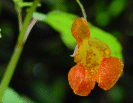Jewelweed
Impatiens capensis
Family: Balsaminaceae
by Liz Marcellus

DESCRIPTION:
Also called Touch-Me-Not.
Jewelweed is a native plant (2-5 ft. tall), found throughout the U.S., mainly in wet, shady areas, especially along streambanks. It is an annual (a plant that lives only one year) that readily reseeds. The seed pods resemble home garden impatiens seed pods. When ripe, the pod splits open upon the slightest touch (hence the name touch-me-not) shooting the seeds out up to 4 feet away. The stems are succulent and juicy. The leaves are oval and have rounded teeth on purple stems. The plants are easy to overlook until late summer when the funnel shaped flowers appear (July-September). They are orange to yellow-orange with reddish spots and are about 1" long. The name jewelweed comes from the fact that water beads up on the surface of the leaf when it gets wet. The water beads look silvery (or jewel-like). This happens because of air trapped in microscopic hairs on the surface of the leaf.
Uses:
The young stems are edible cooked or raw. As a remedy for poison ivy you can mash up a few leaves or use the juice from the stem, rub it on the area or make a poultice to help reduce the inflammation. It also helps for insect bites. A study by a physician found it effective in 108 out of 115 patients. It is also said to help as a poison ivy rash preventative: rub on the juice as soon as you contact the poison ivy. It has also been used as a folk remedy for cuts, bruises, burns, warts and ringworm. Native Americans used the boiled juice to make a golden yellow dye. They also used jewelweed to treat stomach cramps.
Wildlife note:
If you are very lucky (and have a lot of patience, no pun intended!) you might see a hummingbird near the plants. They sip the nectar.
Italics mine (who).